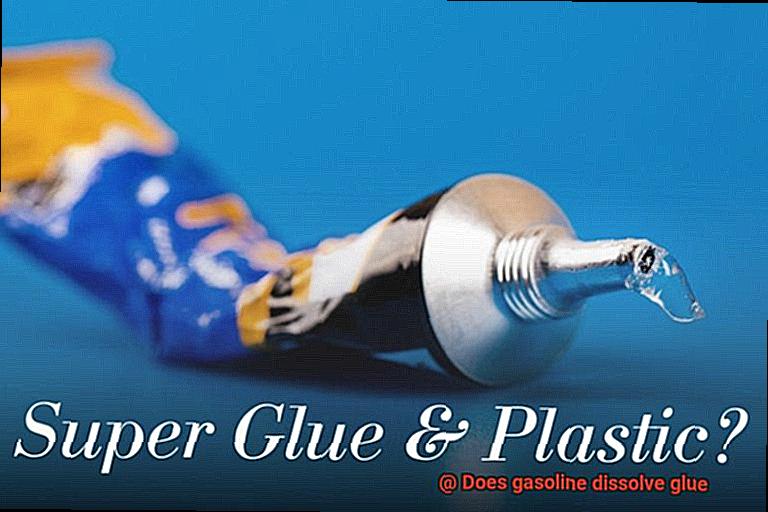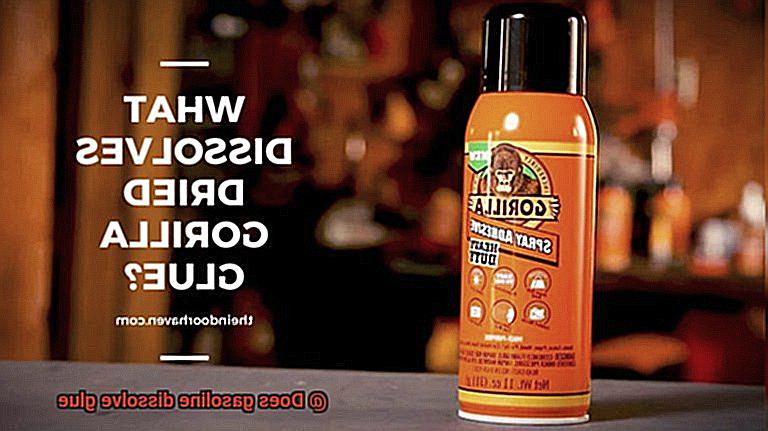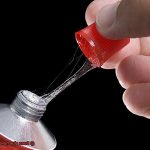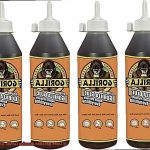Sticky situations, we’ve all been there. From fixing shattered ceramics to rescuing our favorite shoes from sole separation, glue has always saved the day. But what if a rogue spillage of gasoline threatens to undo our carefully crafted fixes? Urban legends whisper that gasoline possesses mystical powers, capable of dissolving even the mightiest adhesives with a single touch.
So, let’s put on our lab coats and embark on a quest to unravel the truth behind this captivating question: Can gasoline truly dissolve glue? Prepare for some myth-busting and uncovering the secrets hidden beneath this age-old debate.
Does Gasoline Dissolve Glue?
Contents
- 1 Does Gasoline Dissolve Glue?
- 2 The Types of Glue That Can Be Dissolved by Gasoline
- 3 The Properties of Gasoline That Make It an Effective Solvent for Glue
- 4 Potential Dangers of Using Gasoline as a Solvent for Glue
- 5 Testing the Effectiveness of Gasoline on Different Types of Glue
- 5.1 What is Glue?
- 5.2 What is Gasoline?
- 5.3 The Experiment:
- 5.4 Firstly, we will label each container with the type of glue being tested. This labeling system ensures accurate observations and prevents any confusion during the experiment. Next, we will apply a small amount of each type of glue onto separate objects and allow them to dry completely.
- 6 Alternatives to Using Gasoline as a Solvent for Glue
- 7 Tips for Removing Adhesive Residues Safely
- 8 Conclusion
Gasoline, renowned for its ability to dissolve oil and grease, is a common fuel used worldwide. On the other hand, glue serves as an adhesive that binds materials together. This article delves into the intriguing question of whether gasoline dissolves glue. We will explore the effects of gasoline on different types of glue, address potential hazards, and provide actionable safety measures to ensure responsible usage.
Effects of Gasoline on Glue:
When gasoline encounters glue, the outcome can vary based on the specific formulation of gasoline and the type of glue involved. In some instances, gasoline causes the glue to soften or partially dissolve.
This reaction weakens the bonding ability of the glue, reducing its effectiveness in adhering materials together. However, it is crucial to recognize that not all glues react similarly to gasoline. Some possess a higher resistance to solvents like gasoline and may remain relatively unaffected by its presence.
Certain glues, such as epoxy or super glues, sport unique chemical compositions that make them less prone to dissolution by gasoline.
Safety Considerations:
The usage of gasoline and glue concurrently necessitates utmost caution due to potential hazards. Gasoline is a highly volatile substance with a propensity for combustion. It is vital to exercise proper ventilation and adhere to safety protocols when working with gasoline and glue together. Below are key safety considerations:
- Well-ventilated areas: Utilize proper ventilation systems to prevent the accumulation of flammable vapors.
- Avoid open flames or sparks: Gasoline is highly combustible, necessitating careful separation from open flames or sparks that could trigger fires or explosions.
- Adequate storage practices: Store gasoline in approved containers within well-ventilated areas away from heat sources.
- Protective gear: When handling gasoline or working with glue, don appropriate protective gear such as gloves and goggles to safeguard your skin and eyes.
- Test inconspicuously: If attempting to remove glued materials using gasoline, conduct a small-scale test on an inconspicuous area to ensure it does not cause damage or discoloration.
The Types of Glue That Can Be Dissolved by Gasoline
Glue is a remarkable adhesive that binds materials together, but when the need to remove it arises, one wonders if gasoline, the lifeblood of our vehicles, can come to the rescue.
In this article, we will delve into the types of glue that can be dissolved by gasoline, unraveling the intricate chemistry behind this phenomenon.
Additionally, we will provide essential safety precautions for using gasoline as a solvent.
The Chemistry of Gasoline and Glue:
Gasoline, a highly volatile liquid composed of potent hydrocarbons like benzene, toluene, and xylene, possesses an uncanny power to dissolve certain types of glue. However, not all glues succumb to its influence; it hinges on their distinctive chemical compositions.
Rubber Cement – The Gasoline’s Friend:
Enter rubber cement—a favored adhesive in arts and crafts projects. This glue, crafted from natural rubber and infused with solvents, is one of the few that gasoline can dissolve. When gasoline infiltrates its sticky embrace, it disassembles the rubber element, leaving the adhesive properties weak and malleable.
Super Glue – Vulnerable to Gasoline’s Power:
Cyanoacrylate glue, commonly known as super glue, wields an unparalleled bond that sets rapidly. Yet, beneath its seemingly invincible facade lies a susceptibility to solvents such as gasoline. Once gasoline permeates the bond forged by this adhesive marvel, it undermines its tenacity and gradually dissolves it into oblivion.
Epoxy Glues – Sensitive Souls:
Epoxy glues are renowned for their Herculean bonding capabilities and resilience against various chemical foes. Alas, even these formidable adversaries have their Achilles’ heel in the face of gasoline. Certain formulations of epoxy glues can be broken down by gasoline, as the solvent stealthily infiltrates the epoxy resin and weakens its bond over time.
Not All Glues Fall Victim:
It is vital to recognize that not all glues yield to gasoline’s persuasive powers. Wood glues, like the venerable PVA (polyvinyl acetate) glues, prove impervious to its charms. Designed to form an unyielding bond with wood surfaces, these glues defy gasoline’s attempts at dissolution, their strength further fortified by water-resistant properties.
Safety Precautions:
Harnessing the power of gasoline as a solvent for glue demands meticulous adherence to safety measures. With its highly flammable nature, gasoline should be handled solely in well-ventilated areas, far removed from any potential ignition sources. Prioritize your safety by conducting a small-scale test on an inconspicuous portion before embarking on the quest to dissolve glue.
The Properties of Gasoline That Make It an Effective Solvent for Glue

Glue can be a formidable foe, but fear not. We have a secret weapon in our arsenal – gasoline. Yes, that everyday fuel for our vehicles holds surprising powers when it comes to dissolving glue. In this blog post, we’ll dive into the properties of gasoline that make it an effective solvent for glue, unlocking its superhero-like abilities.
Versatility: Mixing with Polar and Non-Polar Substances
Gasoline possesses a unique quality – it can mix with both polar and non-polar substances. This means it can break down adhesive bonds effectively, regardless of whether the glue is polar or non-polar.
Penetrating Power: Low Viscosity and Surface Tension
Gasoline’s thin consistency, known as low viscosity, enables it to easily penetrate the adhesive bond of glue. This penetration weakens the glue, making it more susceptible to dissolution. Additionally, gasoline’s low surface tension helps it spread out and come into contact with a larger area of the glue, enhancing its dissolving power.
Quick-Drying Magic: Volatility at Its Finest
One of gasoline’s remarkable properties is its high volatility. It evaporates quickly at room temperature, aiding in the drying process. As the gasoline evaporates, it carries away dissolved glue particles, leaving behind a clean surface ready for your next project.
Non-Polar Solvent Superpowers
Being a non-polar solvent gives gasoline an edge when it comes to dissolving non-polar adhesives, such as those made from petroleum-based materials. Its similar molecular structure allows for better solubility, making it an ideal choice for tackling these types of glues.
Molecular Bonding: Like Attracts Like
Gasoline contains hydrocarbons – organic compounds composed of hydrogen and carbon atoms. Many glues are also made up of organic compounds like polymers or resins. The molecular similarity between gasoline and certain types of glue facilitates better solubility, making it a formidable opponent against adhesive materials.
Potential Dangers of Using Gasoline as a Solvent for Glue
Using gasoline as a solvent for glue may seem like a convenient option, but it comes with a host of potential dangers that should not be ignored. From its extreme flammability to its toxic chemicals and environmental risks, gasoline is far from an ideal choice for dissolving glue.
First and foremost, let’s talk about the flammability factor. Gasoline is notorious for its ability to ignite with even the slightest spark or heat source. Its highly volatile vapors can easily catch fire, turning a simple craft project into a dangerous inferno. Just imagine the horror of accidentally dropping a lit cigarette into your glue container – the result could be a catastrophic explosion. It’s a situation that no one wants to find themselves in.
But the dangers don’t stop there. Gasoline contains a cocktail of harmful chemicals that can pose serious health risks. Benzene, toluene, and xylene are just a few of the toxic compounds found in gasoline. These substances can easily seep into our skin or be inhaled when gasoline vapors are released. Long-term exposure to these chemicals can lead to damage to our central nervous system, liver, and kidneys – definitely not something to take lightly.
And let’s not forget about the environmental impact. Gasoline spills or improper disposal can wreak havoc on our precious planet. The contamination of soil and water sources harms plants and wildlife, disrupting delicate ecosystems. Our crafting adventures shouldn’t come at the expense of Mother Earth.
Luckily, there are safer alternatives available for removing glue residues or dissolving various types of adhesives. Commercial solvents specifically designed for this purpose are formulated to be less flammable and less toxic than gasoline. By opting for these safer alternatives, we can ensure that our crafting endeavors are both enjoyable and safe.
Remember, safety should always be the top priority when working with any solvent – whether it’s gasoline or otherwise. Work in a well-ventilated area, wear protective gloves and clothing, and keep away from any potential sources of ignition. Let’s keep our crafting adventures fun and accident-free.
To sum it all up, while gasoline may have some powerful solvent abilities, the potential dangers associated with its use for glue far outweigh any benefits. Its flammability, toxicity, and environmental risks make it an unsuitable choice. So, let’s leave gasoline where it belongs – in our cars – and opt for safer alternatives that are specifically designed for the task at hand.
Testing the Effectiveness of Gasoline on Different Types of Glue
The purpose of this experiment is to assess the effectiveness of gasoline as a solvent on various types of glue. Glue serves as a bonding agent that helps to join materials together, and there are different types available, such as white glue, super glue, and epoxy adhesive. By conducting this experiment, we aim to determine whether gasoline has the ability to dissolve these different glues. Before delving into the experiment itself, let’s gain a better understanding of both glue and gasoline.
What is Glue?
Glue can be described as a magical substance that possesses the power to stick objects together. It comes in various forms, including liquids, gels, and solids. The secret behind its adhesive properties lies in its unique composition of ingredients. Different glues are specifically designed for bonding particular materials, such as wood glue for woodworking projects or fabric glue for sewing projects.
What is Gasoline?
Gasoline is widely recognized as a fuel used to power vehicles and machinery. However, it also acts as a solvent due to containing hydrocarbon chemicals. These chemicals have the ability to break down bonds within certain substances. Consequently, gasoline may have the potential to dissolve certain types of glue.
The Experiment:
To conduct this experiment, we will need several supplies. These include different types of glue (white glue, super glue, and epoxy adhesive), small objects (such as fabric or plastic), containers for the gasoline, and safety equipment like gloves and goggles.
Firstly, we will label each container with the type of glue being tested. This labeling system ensures accurate observations and prevents any confusion during the experiment. Next, we will apply a small amount of each type of glue onto separate objects and allow them to dry completely.
Once the glue has dried, we will submerge each object into its designated container filled with gasoline. Safety precautions must be taken when handling gasoline, as it is highly flammable. Thus, it is essential to work in a well-ventilated area away from open flames or sparks. The objects will remain submerged for a predetermined amount of time, such as 24 hours, to allow for careful observation.
After the designated time has elapsed, we will remove the objects from the gasoline and inspect the condition of the glue. We will note any signs of dissolution or weakening in the glue’s bond. Additionally, we will compare our findings with a control group where objects with the same types of glue are submerged in water instead of gasoline. This comparison will help determine whether any changes observed are solely due to the effects of gasoline or if they are inherent characteristics of the glue being tested.
Alternatives to Using Gasoline as a Solvent for Glue
Struggling to remove glue from a surface often leads to the temptation of using gasoline as a solvent. However, the high flammability of gasoline poses serious safety risks. Luckily, there are safer alternatives available. In this article, we will explore some effective and secure options for removing glue without relying on gasoline.
Rubbing Alcohol: The Versatile Solution
- Also known as isopropyl alcohol, rubbing alcohol is a household item that effectively dissolves many types of glues.
- It evaporates quickly, leaving minimal residue and making it safe for use on various surfaces.
Acetone: The Super Glue Buster
- Acetone is a potent solvent found in nail polish removers that effectively dissolves tough adhesives like super glue.
- While highly effective, it should be used with caution due to its flammability and potential skin irritation.
Vegetable Oil: Safe and Non-Toxic
- A natural alternative, vegetable oil can loosen and remove certain types of glues.
- Although not as powerful as gasoline or chemical solvents, it is safe, non-toxic, and readily available at home.
Warm Soapy Water: The Gentle Approach
- For water-based glues or those not fully dry, soaking the affected area in warm soapy water can effectively loosen and remove the glue.
- This method is particularly suitable for delicate surfaces that may be damaged by harsh chemicals.
Tips for Removing Adhesive Residues Safely
Adhesive residues can be a real sticky situation. They can leave behind a gooey mess that is hard to clean. That’s why it’s important to remove adhesive residues safely to avoid any damage to the surface or potential harm to yourself. Here are some tips to help you tackle those stubborn residues like a pro.
Use Rubbing Alcohol or Isopropyl Alcohol
One easy and effective method for removing adhesive residues is to use rubbing alcohol or isopropyl alcohol. These alcohols have the ability to break down many types of adhesives without causing any damage. Simply apply a small amount of alcohol onto a cloth or cotton ball and gently rub the residue until it loosens and can be easily wiped away.
Try Citrus-Based Solvents or Adhesive Removers
Another great option is to use a citrus-based solvent or adhesive remover. These specially designed products can dissolve adhesives without harming the surface. They often have a pleasant scent and can be found in most hardware or home improvement stores. Apply the solvent onto a cloth or sponge and gently rub the residue until it dissolves.
Use Heat to Loosen Stubborn Residues
For particularly stubborn adhesive residues, heat can be your secret weapon. Grab a hairdryer or heat gun set on low heat and direct it towards the residue. The heat will soften the adhesive, making it easier to remove. But remember, caution should be exercised when using heat, especially on delicate surfaces, as excessive heat can cause damage.
Get Oily with It
Sometimes, a simple oil like coconut oil or baby oil can do the trick. Apply a small amount of oil onto a cloth and gently rub the residue until it loosens. The oil helps break down the adhesive, making it easier to remove.
Test Before You Tackle
Different adhesives may require different removal methods, so it’s always a good idea to test any solvent or method on a small inconspicuous area first. This way, you can ensure that it won’t cause any damage before applying it to the entire residue.
_59ZzuLJcTw” >
Conclusion
To conclude, the notion that gasoline can dissolve glue holds some truth, but its effectiveness depends on the type of glue and the formulation of gasoline. Certain glues, like rubber cement, super glue, and certain epoxy glues, can be softened or partially dissolved by gasoline. However, not all glues react to gasoline in the same way. Glues with unique chemical compositions, such as wood glues or PVA glues, generally resist dissolution when exposed to gasoline.
While gasoline can effectively eliminate adhesive residues, it is crucial to exercise caution due to its highly flammable nature and potential health hazards. Adequate ventilation, avoiding open flames or sparks, and donning protective gear are indispensable safety precautions when working with both gasoline and glue.
It is advisable to explore safer alternatives for removing glue residues or dissolving various types of adhesives. Rubbing alcohol, acetone, vegetable oil, and warm soapy water are effective options that pose less risk in terms of flammability and toxicity compared to gasoline. Before applying any solvent or method to the entire residue area, it is essential to conduct a small test on an inconspicuous spot.
In summary, while gasoline does possess some solvent properties for specific types of glue, the potential dangers associated with its use outweigh any benefits.






